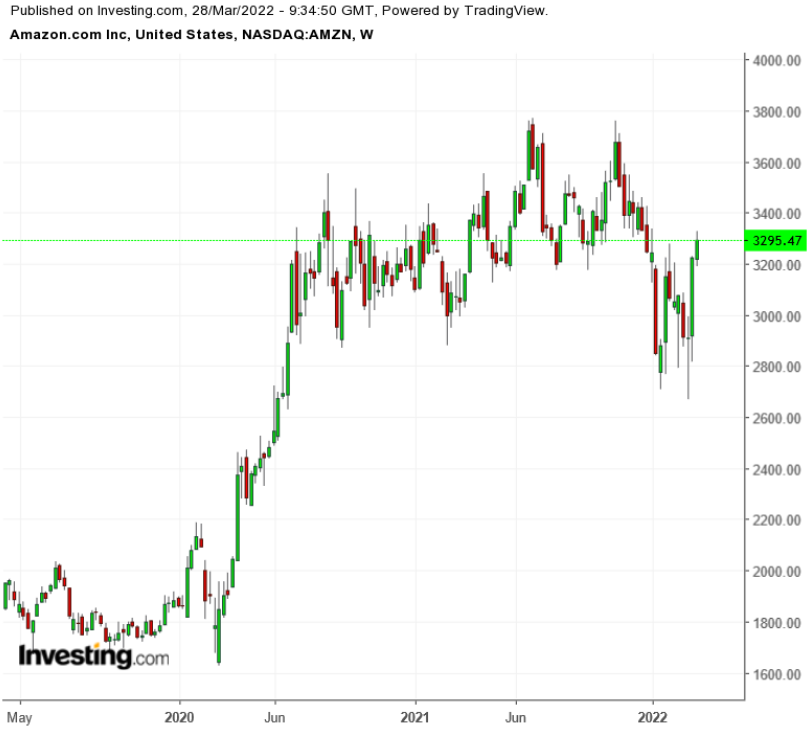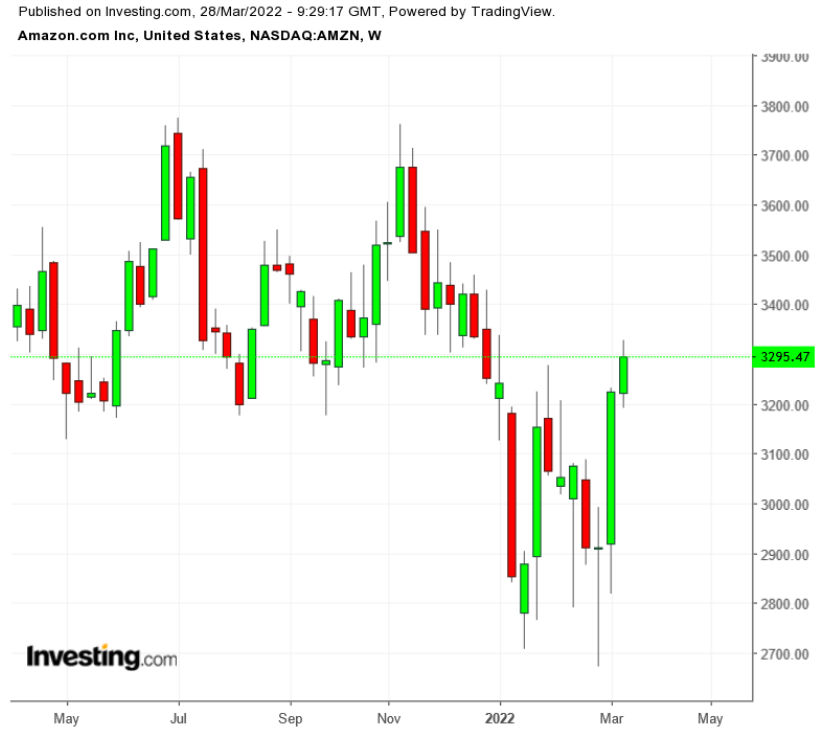There are plenty of reasons for skepticism of Amazon (NASDAQ:AMZN) stock right now. The Seattle-based internet retail behemoth is an exceptional company with a staggering $469 billion in 2021 revenue. But the stock, which closed at $3,295.47 on Friday, also has a valuation north of $1.6 trillion and the highest price-to-earnings multiple of any mega cap.

On their face, fourth-quarter earnings looked hugely impressive, but benefited from a one-time gain related to one of its investments. The stock itself has been mostly stuck since July 2020, but at the same time, a recent rally from a 20-month low seems like potentially too much.
Yet, looking closer, there's still plenty of room for optimism, not skepticism. Amazon is one of the world's best businesses, and just as importantly Amazon stock is much cheaper than it looks. With a new, more shareholder-friendly policy likely in place, there's still plenty of room, and reason, for AMZN to move higher.
Did the Amazon Stock Split Matter?
On Mar. 10, Amazon stock rose 5.4%.

That's a reasonably significant move, accounting for a roughly $75 billion increase in the company's market capitalization. The fact that the gains came on a down day for the market—the NASDAQ Composite fell almost 1% during that session—made the move all the more impressive.
The catalyst for the rally seemed a bit strange to some observers. The day before, after the market close, Amazon had announced a 20-for-1 stock split as well as a $10 billion share repurchase.
In theory, the announcement shouldn't have moved AMZN stock much, if at all.
After all, a stock split does not on its own change the value of a company. A split perhaps can help investor demand on the margins, as retail investors can pay less for a single share. But fractional shares already are available at essentially every major brokerage. And with Amazon's market cap, at the time, just shy of $1.5 trillion, increased small-investor demand seemed, and still seems, unlikely to have much in the way of impact.
The same issue holds for the share repurchase. Buying back $10 billion in stock with $10 billion in cash—again, in theory—shouldn't change the overall value of the enterprise. The vote of confidence in the stock from the board of directors perhaps is helpful, but, again, Amazon added roughly $75 billion in value in a single session.
Indeed, a few investors joked on social media about the move in Amazon stock, which was as high as 10% in after-hours trading immediately following the announcement, disproving the efficient market hypothesis.
Yet in practice, if not in theory, the split and buyback do matter. Since its founding, Amazon has been a customer-first company. That focus has done wonders for Amazon stock, which, adjusted for previous stock splits (back in the late 1990s), has risen more than 2,000x. (Put another way, a $500 investment in the 1997 initial public offering would now be worth just over $1 million.)
There's room for new CEO Andy Jassy to pay attention to shareholders as well. And the stock split and the buyback are potentially a small, first step. One of the core arguments for owning AMZN stock is that valuation is reasonable relative to earnings and free cash flow—and that those metrics are actually depressed by Amazon's endless investments.
We don't know, and can't know, how much profit Amazon could generate if it focused solely on the near-term bottom line. Almost certainly, however, there is plenty of fat for Jassy to cut. Amazon has already announced the closure of 68 physical retail stores. Investments the company has made in drones, hardware, and other lower-margin items may well be next.
As with the stock split and the buyback, in theory these moves perhaps shouldn't change Amazon's value all that much. The market to some extent probably knows that Amazon has been underearning.
But Jassy's moves so far signal a path in which Amazon keeps its relentless focus on customers while staying in markets where that focus gives it leadership and some level of profitability. On that path, Amazon's profit margins and growth should improve nicely—and that's a big potential catalyst for the stock.
Understanding Amazon's Valuation
Admittedly, even with good news it still seems as though Amazon stock is potentially badly overvalued. Shares trade at 50x 2021 earnings—but that EPS figure was inflated by a fourth-quarter gain on Amazon's investment in electric truck manufacturer Rivian Automotive (NASDAQ:RIVN).
Back that out, and AMZN trades at almost 80x trailing earnings. (The 55% decline in RIVN stock year-to-date, meanwhile, means that the investment will post a large loss when Amazon reports first quarter 2022 earnings.)
But looking at Amazon by regional as well as corporate segments shows a much more reasonable fundamental profile than that headline multiple might suggest. The North America segment—which includes the online and physical businesses on the continent—posted operating margins of just 2.6% in 2021. That compares to better than 4% in 2019. Again, investments appear to be a big factor, as Amazon continues to build out its logistics and expands its delivery service and offerings.
There's huge room for improvement there. The US business for Walmart (NYSE:WMT), even adding back all of that company's corporate overhead, generates margins just above 5%. If Amazon can get its North America segment just to 4%, that alone suggests ~15% post-tax EPS growth against the 2021 baseline (again, excluding the impact of the Rivian investment).
The International segment remains narrowly unprofitable on an operating basis. Over time, that will change as the business matures. (Indeed, that's precisely the path the North American business took, while bears claimed the stock was “overpriced” in the triple-digits.) Each 1% of operating margin gained overseas adds another ~4% in net earnings.
Then there's Amazon Web Services, the company's cloud business. AWS is a monster—in a good way. In 2021, the segment generated more than $62 billion in revenue—at operating margins just shy of 30%.
If AWS were a standalone business, at a 21% tax rate (the federal levy; Washington state does not have a corporate tax), it would generate net profit just shy of $15 billion. It's not terribly difficult to argue that such a business would near or even exceed a $1 trillion valuation, given the impressive margins and revenue growth.
Indeed, while skeptics pointed to Rivian's impact on Amazon's fourth-quarter earnings 'beat', it was likely strength in AWS that sent AMZN stock shooting higher after earnings.
Headline multiples make Amazon stock look expensive. A closer look, however, indicates the valuation appears far more reasonable.
As such, the case for AMZN is the ability to own what is literally one of the world's best businesses at a reasonable valuation, with many, many years of growth still ahead. In retail, in media, in its AWS cloud business, and internationally, Amazon.com has only scratched the surface of its potential for revenue and margins.
In truth, that's been the core case for Amazon stock for most of the past quarter-century. In our view, it remains a solid case for the next 25 years as well.
Which stock should you buy in your very next trade?
With valuations skyrocketing in 2024, many investors are uneasy putting more money into stocks. Unsure where to invest next? Get access to our proven portfolios and discover high-potential opportunities.
In 2024 alone, ProPicks AI identified 2 stocks that surged over 150%, 4 additional stocks that leaped over 30%, and 3 more that climbed over 25%. That's an impressive track record.
With portfolios tailored for Dow stocks, S&P stocks, Tech stocks, and Mid Cap stocks, you can explore various wealth-building strategies.
